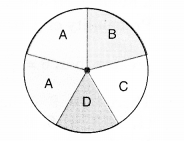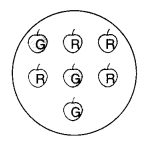NCERT Solutions for Class 8 Maths Chapter 5 Data Handling Ex 5.3 are part of NCERT Solutions for Class 8 Maths. Here we have given NCERT Solutions for Class 8 Maths Chapter 5 Data Handling Ex 5.3.
| Board | CBSE |
| Textbook | NCERT |
| Class | Class 8 |
| Subject | Maths |
| Chapter | Chapter 5 |
| Chapter Name | Data Handling |
| Exercise | Ex 5.3 |
| Number of Questions Solved | 6 |
| Category | NCERT Solutions |
NCERT Solutions for Class 8 Maths Chapter 5 Data Handling Ex 5.3
Question 1.
List the outcomes you can see in these experiments.
(a) Spinning a wheel

(b) Tossing two coins together
Solution.
(a) Outcomes in spinning the given wheel are A, B, C and D.
(b) Outcomes in tossing two coins together are HT, HH, TH, TT (Here HT means Head on first coin and Tail on the second coin and so on).
Question 2.
When a die is thrown, list the outcomes of an event of getting
(i)
(a) a prime number
(b) not a prime number
(ii)
(a) a number greater than 5
(b) a number not greater than 5.
Solution.
Possible outcomes are:
1, 2, 3, 4, 5, and 6.
Out of these, prime numbers are
2, 3 and 5.
(i)
(a) Outcomes of an event of getting a prime number are: 2, 3 and 5
(b) Outcomes of an event of not getting a prime number are 1, 4 and 6.
(ii)
(a) Outcomes of an event of getting a number greater than 5 are 6
(b) Outcomes of an event of getting a; number not greater than 5 are 1, 2, 3, 4 and 5.
Question 3.
Find the
(a) Probability of the pointer stopping on D in (Question l-(a))?
(b) Probability of getting an ace from a j well shuffled deck of 52 playing cards?
(c) Probability of getting a red apple. (See figure)

Solution.
(a) There are in all 5 outcomes of the event. These are A, B, C and D. The pointer stopping on D has only 1 outcome, i.e., D
∴ Probability of the pointer stopping on D =\(\frac { 1 }{ 5 } \)
(b) Total number of playing cards = 52 Number of possible outcomes = 52
Number of aces in a deck of playing cards = 4
cards = 4
∴ Probability of getting an ace from a well shuffled deck of 52
playing cards = \(\frac { 4 }{ 52 } \) = \(\frac { 1 }{ 13 } \)
(c) Total number of apples = 7
Number of red apples = 4
∴ Probability of getting a red apple = \(\frac { 4 }{7} \)
Question 4.
Numbers 1 to 10 are written on ten separate slips (one number on one slip), kept in a box and mixed well. One slip is chosen from the box without looking into it. What is the probability of?
(i) getting a number 6?
(ii) getting a number less than 6?
(iii) getting a number greater than 6?
(iv) getting a 1-digit number?
Solution.
Total number of outcomes of the event (1, 2, 3, 4, 5, 6, 7, 8, 9 and 10) = 10
(i)
∵ Number of outcomes of getting a number 6=1
∴ Probability of getting a number \(\frac { 1 }{10} \)
(ii)
∵ There are 5 numbers (1, 2, 3, 4 and 5) less than 6.
∴ Number of outcomes of getting a number less than 6 = 5
∴ Probability of getting a number less than \(6=\frac { 5 }{ 10 } =\frac { 1 }{ 2 } \)
(iii)
∵ There are 4 numbers (7, 8, 9 and 10) greater than 6
∴ Number of outcomes of getting a number greater than 6 = 4
∴ Probability of getting a number greater than \(6=\frac { 4 }{ 10 } =\frac { 2}{ 15 } \)
(iv)
∵ There are 9 1-digit numbers (1, 2, 3, 4, 5, 6, 7, 8 and 9)
∴ Number of outcomes of getting a 1-digit number = 9
∴ Probability of getting a 1-digit number \(=\frac { 9 }{ 10 } \)
Question 5.
If you have a spinning wheel with 3 green sectors, 1 blue sector and 1 red sector, what is the probability of getting a green sector? What is the probability of getting a nonblue sector?
Solution.
Number of green sectors = 3
Number of blue sectors = 1
Number of red sectors = 1
∴ Total number of sectors = 3 + 1 + 1=5
∴ Total number of outcomes of the event = 5
Number of outcomes of getting a green sector = 3
∴ Probability of getting a green sector = \(\frac { 3 }{ 5 } \)
Number of outcomes of getting a non-blue sector = Number of green sectors + Number of red sectors
=3+1=4
∴ Probability of getting a non-blue sector = \(\frac { 4 }{ 5 } \).
Question 6.
Find the probabilities of the events given in Question 2.
Solution.
Total number of outcomes of the event (1, 2, 3, 4, 5 and 6) = 6
(i)
(a) Number of prime numbers (2, 3 and 5) = 3
∴ Number of outcomes of getting a prime number = 3
∴ Probability of getting a prime number = \(\frac { 3 }{ 6 } =\frac { 1 }{ 2 } \).
(b) Number of non-prime numbers (1, 4 and 6) = 3
∴ Number of outcomes of getting a non-prime number = 3
∴ Probability of getting a non-prime number = \(\frac { 3 }{ 6 } =\frac { 1 }{ 2 } \).
(ii)
(a) Number greater than 5 = 6, i.e., only one.
∴ Number of outcomes of getting a number greater than 5 = 1
∴ Probability of getting a number greater than 5 = \(\frac { 1 }{ 6 } \).
(b) Number of numbers not greater than 5 (1, 2, 3, 4 and 5) = 5
∴ Number of outcomes of getting a number not greater than 5 = 5
∴ Probability of getting a number not greater than 5 = \(\frac { 5 }{ 6 } \).
We hope the NCERT Solutions for Class 8 Maths Chapter 5 Data Handling Ex 5.3 help you. If you have any query regarding NCERT Solutions for Class 8 Maths Chapter 5 Data Handling Ex 5.3, drop a comment below and we will get back to you at the earliest.